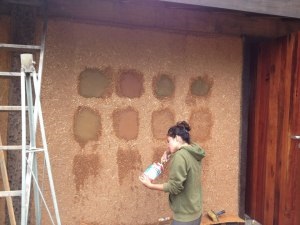In the video below, I cover some basic tests you can do to analyse your earth for rendering. It is important to do as many tests as you can before applying an earthen plaster finish. For me the main reason for doing this at every job is that the earth is always going to be a little bit different, even if in this case the earth was mined from the same site as a previous job.
Why We Do Render Tests for Earthen Walls
We knew from before that this particular mine gave earth with a very nice percentage of clay to sand (minute 25:75 in the video), which was ideal to work with, but even so we still carried out the basic tests to see how the mixtures fared in our particular conditions.
Another good reason for doing tests in this site in particular is that we were working on to cement block walls and even a modern paint in one of the spaces. For this reason it was very important to see whether the render would even stick, especially in the case of the smooth-rendered, modern white-painted walls.
So as with any job we made our tests, changing the quantity of sand to clay in each case. We had four different surfaces to work on to and we made four different mixtures. On past jobs I have done up to 12 tests and depending on the materials you are using and the parameters you want to test. In this case, we had two ingredients, sand and earth, so we didn’t have to do quite so many tests. When testing a render on an exterior wall with four ingredients, where colour, texture as well as water resistance was important, this is where we did 12 tests.
How to Create Test Mixes for Earthen Walls
A quick run down of the process is as follows:
- Check you earth for clay content using the jar and water test
- Your ideal mixture is around 75 percent sand 25 percent clay so add sand or clay depending on your jar results.
- If your mix is very close to ideal then try it without altering it as well.
- Make a clay slip to use as a glue paint, this is made by fine filtering clay earth and adding water till it is a nice paste consistency
- Wet your wall using a wet brush or hose ten minutes before application.
- Make half a bucket of each mixture. Mix ingredients dry then add water till render is a workable consistency
- If wall is dry when you are ready to start then apply water again.
- Apply render by hand or tool.
- Mark each mixture to show what the ratio of sand to earth is.
- Wait a week or more for the mix to dry and then apply strength and aesthetic tests.
- For internal walls tests will be checking for cracks, checking if render has come away from the wall, checking if the render dusts off the wall too much and finally whether the render is much damaged through impact (for that I use a hammer).
For any clarifications please get in touch via the comments here or through our website.


Tom Keelingis based in Portugal and has traveled throughout Brazil and Eastern Europe learning about natural building and farming. He’s working on a two-story stone barn renovation using clay and wood, and including a shower and toilet block built using rammed earth and adobe bricks. Connect with Tom at Fazenda Tomati and on Facebook and Instagram. Read all of his MOTHER EARTH NEWS posts here.
All MOTHER EARTH NEWS community bloggers have agreed to follow our Blogging Guidelines, and they are responsible for the accuracy of their posts.
